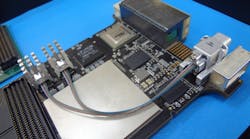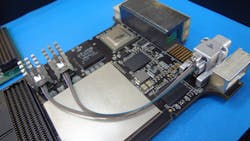I was recently at VITA's Embedded Tech Trends where I had a chance to chat again with Ray Alderman, the chairman of VITA's board. Ray has been working on computers for a long time. We were reminiscing about debugging. It turns out that we both worked for Burroughs about the same time in the 70's although he was in Detroit while I was out in Pennsylvania.
Related Articles
- Gallery: VPX Board Utilizes VITA 66.4 Optical Backplane
- New Gear Accelerates And Simplifes 100/400-Gbit/s Optical Testing
- Use Photonics To Overcome The High-Speed Electronic Interconnect Bottleneck
We both worked with a lot of the Burroughs (now Unisys) equipment including the B6700/B7700 and the B1700. It was cutting edge stuff. If you ever wondered about the Master Control Program (MCP) just check out Burroughs history.
The B1700 was interesting because it had a programmable nanoprogram and microprogram memory so instruction sets were soft. There was one for RPG, another for FORTRAN and yet another for COBOL. Of course there was an Algol version as well since the mainframes ran Algol. It was also a variable length, bit addressable memory system.
It was flexible but it led to some interesting problems because there was only enough memory for one interpreter. The nano and micro memories were updated if the system had to switch to another type of program. In general it was better to run the same kind of applications at the same time to minimize swapping.
Ray used to fix systems that drove others nuts because they could not figure out why there was a slow down. He mentioned an interesting trick that helped him diagnose problems along these lines. It turns out that the system's power supplies had weak but audible tone that he could hear and they tones gave a rough estimate of what the system was up to. He could walk into a room where the problem child was and just listen. He then walks over to the system controls and points out the problem.
Ray has been pointing out problems and solutions ever since. His latest missive, Obituary for Backplane-Based Systems and Connectors can be found on on Connector Supplier. Here is an exerpt.
It's pretty clear, at this point, that copper backplanes and copper backplane connectors are just brothels housing promiscuous electrons. Photons have much higher morals and can eliminate many of the transgressions that copper backplanes and copper connectors commit. Hopefully, this article will stir some mental effort in the cube farms of the backplane connector vendors, and they will see the light. (see Obituary for Backplane-Based Systems and Connectors at Connector Supplier)
It is true that Ray is not alone in this discussion but fiber has only found a niche thus far. It may take a little longer and the push is likely to come from high performance systems that really need it like a VPX platform that is handling massive amounts of data from phase radar systems but eventually this stuff trickles down.
The VITA 66.4 optical backplane standard is the start at least in the military space. Pentek already has an FMC carrier board (Fig. 1) that supports VITA 66.4 (see Gallery: VPX Board Utilizes VITA 66.4 Optical Backplane). This adds 12 fiber channels via the backplane on the P2 area but does not replace the P0 or P1 used for copper-based networking.
The challenge is that we have been pushing copper as far as possible. We moved from parallel buses to high speed serial channels and then combining multiple channels together. This is similar to the issue we have with processors. We have switched to packing as many cores into a chip as possible.
So far we have still not hit the barrier for most applications and in many instances we never will. Connecting a fiber cable to a single chip micro that is going to open a door makes no sense unless someone is worried about static electricity sparking a fire.
Still, optical connections provide the bandwidth needed in high performance applications that continue to require more and more bandwidth. There are a number of added benefits to using optical though. The primary advantage is distance. Serial copper connections pushed past parallel buses but optical makes copper seem silly. Active optical cables for USB 3.0 and Thunderbolt (see Thunderbolt and Light Peak) can run over 100 meters. Another advantage is minimal, almost non-existant crosstalk and significantly easier routing.
Fiber is a well known item though especially in the networking arena. Fiber to the home is available from Verizon and optical cable connects the world where wireless is not used. The technology for using optical on the backplane is comparable to that used in the networking world but backplanes have different requirements.
In the past, cost was a major issue but lower cost fiber support and higher cost, high speed copper connections makes the crossover point to optical lower. Mating fiber on the backplane is an issue especially in rugged environments where dirt and grime can cause major problems. It is an issue even with high speed copper connectors but seeing a problem on a fiber connection is demanding at best.
Some might have laughed at shows like Star Trek where computers had all sorts of fiber cables hanging out the back but it may not be as far from reality given the move to optical connections. Backplanes may move to optical connections with light channels but for now fiber cable is likely to be the norm.
Those old Burroughs machines were wire-wrapped monsters running the the megahertz range connected to multidrop RS-485 serial terminals running at 19.2 Kbaud. I just wonder how we are going to debug fiber systems. Maybe Google Glass would be useful.

